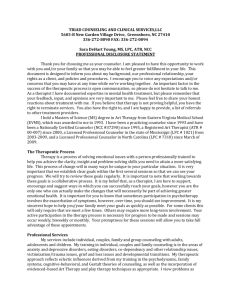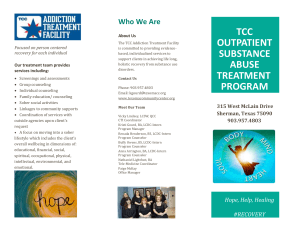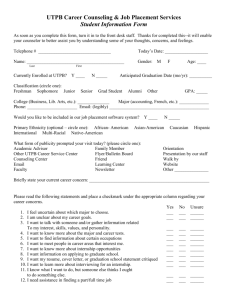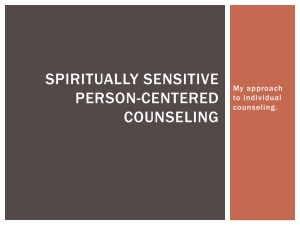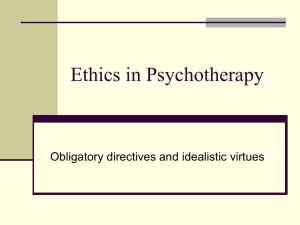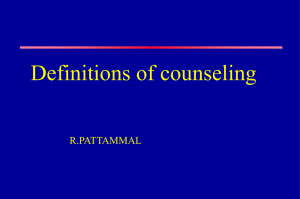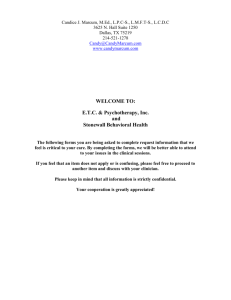Roger
advertisement
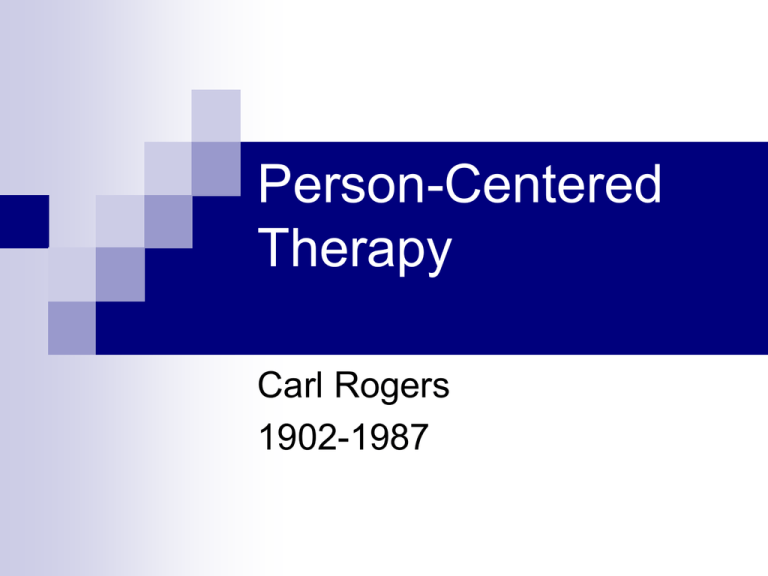
Person-Centered Therapy Carl Rogers 1902-1987 Biography Child Guidance Clinic- Rochester 1939 Published The Clinical Treatment of the Problem Child Ohio State University – Professor 1939 1942 Published Counseling and Psychotherapy Tapes and transcribes therapy sessions to study more objectively therapy process and outcome 2 Biography U. of Chicago, Professor and Director Counseling Center 1945 U. Wisconsin-Madison 1957 Research with hospitalized patients Higher levels of accurate empathy leads to more positive outcomes Client's perception of the relationship is better predictor of outcome than therapist's perception of the relationship Center for Studies of the Person in California 1968 3 Humanistic Psychology Each of us has a natural potential that we can actualize and through which we can find meaning in life Emphasizes the importance of the person's subjective experience approach – exploration method that uses human experience as main source of data Phenomenological 4 Human Nature: Main Concepts Self-Actualizing Tendency Basic human drive toward growth, completeness, and fulfillment Internal Locus of Evaluation Events that enhance the self actualizing tendency are judged positively and vice-versa. Need for Positive Regard Feeling accepted by others 5 Human Nature: Main Concepts Self-Concept/Self-Regard Learned through the perceptions of regard and acceptance from others Conditions of Worth Expectations or demands we perceive from others in order to receive their acceptance These perceptions are internalized and sometimes are out of our awareness 6 Psychopathology INTERNALIZED CONDITIONS OF WORTH block the natural SELFACTUALIZING TENDENCY, creating a state of INCONGRUENCE between what we experience from within (internal locus) and what we believe we should be (conditions of worth) To resolve the conflict, typically we distort or block the experiences from within 7 Anxiety State of uneasiness or tension that occurs when the discrepancy between what I feel I need to be or do to be accepted and what I really want to do (internal locus of control) threatens to emerge Defense mechanisms are invoked to distort the "experiencing" from within, so that the person can conform with internalized external expectations (perceived or real) 8 Goal of Therapy Facilitate the client’s exploration of the parts of themselves that they have denied or distorted, to promote the self actualization process Given right therapeutic climate, clients will Become more open to experience Achieve self-trust Develop an internal source of evaluation Be willing to continue growing 9 Therapy Relationship: Three Conditions Congruence or genuineness Agreement between the feelings and attitudes a therapist is experiencing and his or her professional demeanor (Un)conditional positive regard Nonpossessive caring and acceptance of the client Accurate empathic understanding ability to deeply grasp the client's subjective world 10 Evolution of the Approach Non-Directive Therapy Client Centered Therapy Person Centered Therapy 11 Person Centered Therapy Emphasizes: Therapy as a journey shared by two fallible people The person’s innate striving for self-actualization The personal characteristics of the therapist and the quality of the therapeutic relationship The counselor’s creation of a permissive, “growth promoting” climate Being present in the relationship and focus on the client’s immediate experience 12 Interventions Communicating Empathy Attentive/Active listening Express understanding Openness to the client’s perspective Techniques Reflection of feeling: explicit and implicit Paraphrasing and synthesizing 13 Motivational Interviewing Humanistic, client-centered, psychosocial, directive counseling approach Initially designed as a brief intervention for problem drinking Promotes a collaborative process that focuses on solutions for behavioral problems – avoids a confrontational style Emphasizes client’s abilities, strengths, resources, and competencies Theory and Practice of Counseling and Psychotherapy - Chapter 7 (15) ©2013 Brooks/Cole Cengage Learning Motivational Interviewing Goal: reduce ambivalence and increase intrinsic motivation to change Reluctance to change - considered normal and expected part of the therapeutic process Reflective listening, empathy, open-ended questions, nonconfrontational approach to resistance, support To increase motivation to change, reflect discrepancies between behaviors and values Elicit and reinforce “change talk” Stage of Therapy Process • Pre-Contemplation No intention of changing Counselor: Nurturing Parent • Contemplation Awareness of problem, no commitment to change Counselor: Socratic teacher • Preparation Intend to take action; small changes Counselor: Coach • Action Engaged in change process Counselor: Consultant • Maintenance Consolidate gains and avoid relapse Counselor: Consultant 16 Contributions Roger’s Theory Importance of the person of the counselor and of the relationship in the therapeutic process Initiated research in therapy process and outcome by taping sessions and studying the transcription of tapes Research findings provide support for the importance of empathy in therapy outcome (Watson’s 2002 review) 17 Limitations Therapeutic conditions are necessary but not sufficient Lack of clear goals and structure Lack of challenge to clients Lack of guidance regarding behavioral change 18
